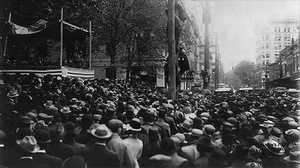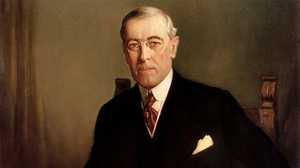Ellen Axson Wilson

The future 28th first lady was born in Savannah, Georgia, on May 15, 1860, and lived most of her childhood in Rome, Georgia; An extremely bright but shy girl, Ellie Lou, as she was known, read widely and even taught herself trigonometry. She graduated from Rome's Female College, and was recognized for her artistic ability. At eighteen, she won a bronze medal for freehand drawing at the Paris International Exposition, and launched a promising career as a professional artist. A few years later, when her mother died and her father suffered a severe mental breakdown, Ellen's plans for a career as an artist were derailed. Her siblings looked to Ellen as the head of their suddenly parentless household.
Woodrow Wilson, then a lawyer, came into Ellen's life when he visited Rome on business and they met at church. A cousin once said that if Ellen ever married, the man would probably be of no consequence, since smart men were rarely interested in smart women. But Woodrow Wilson was eager for the love and support of a strong woman like Ellen. Almost immediately engaged, the couple waited to marry for two years because both had decided to continue their studies. Woodrow entered graduate school, while Ellen, whose father had died while confined to a mental asylum, used money from her modest inheritance to restart her study of art at the innovative Art Students' League in New York City. After marriage, Ellen devoted herself to her family and to Woodrow's career, garnering private praise as her husband's intellectual equal.
As Woodrow Wilson's name became more recognized, Ellen submitted her paintings to exhibitions under an assumed name. The paintings were often accepted. For a brief time, an independent profession seemed possible. Yet Ellen chose to focus on raising her daughters and taking care of her extended family, some of whom lived with the Wilsons.
It was during Wilson's tenure at Princeton University that Ellen found herself in the role of the betrayed wife. Staying at home to care for her family, she sent Wilson alone to Bermuda on holiday in 1907. There, he met socialite Mary Peck, and began a dalliance that would extend through a second Bermuda visit the following year. When Ellen discovered her husband's infidelity, she was grief-stricken -- and he was guilt-stricken. But she eventually forgave him, and the couple moved on.
Thrust into the role of first lady upon Woodrow's election as president in 1912, Ellen Wilson's artistic desire gave way to official duty. She installed a studio with a skylight on the top floor of the White House, but found little time to use it. While previous first ladies worked behind the scenes, Ellen took on a direct, public role. Her political advocacy included, among other issues, opposition to child labor, help for the mentally ill, and better working conditions for women. She sought to improve living conditions in Washington's squalid ghettos by personally leading tours for Congressmen through the abysmal alleys. Her efforts resulted in a federal law bearing her name.
Only a year into her husband's first term in office, Ellen Wilson was diagnosed with a liver condition called Bright's Disease. Concerned foremost, as always, with her husband's well being, she exacted a promise from the family physician to look after Woodrow when she no longer could. Ellen Wilson died at the age of 54 as war was breaking out in Europe.
In the days after her death, Wilson wandered alone through the White House. He was heard by his staff to mutter one phrase, again and again. "My God, what am I to do?







